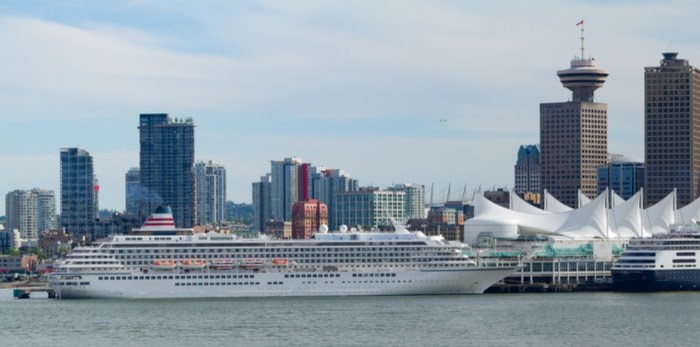The World Wildlife Fund Canada is urging Transport Canada to put in place additional regulations around the dumping of marine grey water after a new study suggested as much as 1.5 billion litres of grey water was generated by ships off B.C.’s coast in 2017.
The study, commissioned by the WWF and carried out by Vancouver’s Vard Marine, also noted the vast majority — 1.37 billion litres of the grey water — is generated by cruise ships.
 Cruise ship in Vancouver/Shutterstock
Cruise ship in Vancouver/Shutterstock
Grey water is the waste water from sinks, laundry machines, bath tubs, shower stalls and dishwashers.
It does not include sewage (black water), or drainage from machinery spaces or workshop areas.
“Part of this is about Transport Canada putting the right rules in place to deal with this waste stream,” said the WWF’s Andrew Dumbrille. “The only regulations are to treat it through a marine sanitation device [and discharge] when beyond three nautical miles [of land].”
Dumbrille said the driving force behind the study was to get a sense of how much grey water is being generated on the coast, and to start a conversation about mitigation measures.
He conceded there is no sense that there is a massive problem with dumping in this region, and the report itself points out it would be difficult to determine where and how much grey water is discharged into the ocean.
The report also notes the data is based on a set of assumed metrics and while it may be useful in evaluating risk and studying vessel traffic patterns it “may not be a basis for determining where and how much grey water ends up in the ocean.”
Dumbrille said with cruise ship traffic increasing along with other nautical traffic, it’s important to determine where the waste streams end up. “Grey water contains a lot of potentially damaging elements to ocean ecology. If volumes are enough and they are being dumped in sensitive areas I think there is an issue and the problem needs to be dealt with,” he said.
Dumbrille said there are a variety of measures he would like to see in place to deal with grey water, from tighter federal regulation to monitoring and enforcement.
He said there’s room for cruise ships to do more to manage the waste by using soaps and detergents that have less impact on the environment.
Donna Spalding, spokesperson for the Cruise Lines International Association, said they would need to dive a little deeper into the report’s findings and usage assumptions before determining if it was onto something.
She said Transport Canada does have regulations in place requiring vessels disposing of grey water to have the water passed through a marine sanitation device or done beyond a three-mile distance from land.
And she pointed out cruise ships tend to go beyond those regulations.
Spalding said most ships in the B.C. region have imposed their own regulations requiring them to be at least four nautical miles away from land and travelling at no less than six knots when they discharge grey water.
She pointed out nearly 70 per cent of all ships cruising in this region use advanced wastewater treatment systems — and all new cruise ships have wastewater treatment centres built-in.
Transport Canada also appears to be ahead of the curve, or at least WWF’s request, on the question of grey water.
This year, Transport Canada and the National Research Council of Canada launched a project looking at the management of grey water.
They are compiling information on the generation, collection, storage, re-use, and disposal of marine grey water, and looking at existing treatment options from the perspectives of marine vessel operators.
The WWF-commissioned study did not include BC Ferries in its report.
According to BC Ferries, vessels built before 2013 do discharge grey water into the sea, while new vessels do not.
“All water from toilets [sewage] goes into shoreside facilities at our various terminals,” said spokesperson Deborah Marshall.
“We actually had a major program with a cost of about $50 million to hook into municipal sewage plants across the fleet.”
The Coho car ferry has an on-board advanced-treatment system for its waste.


